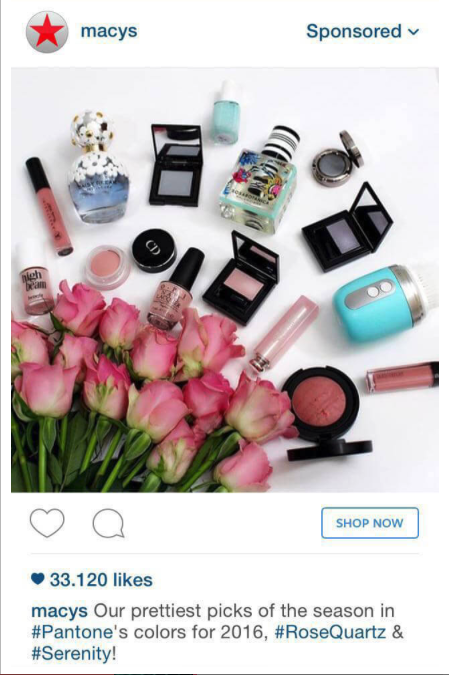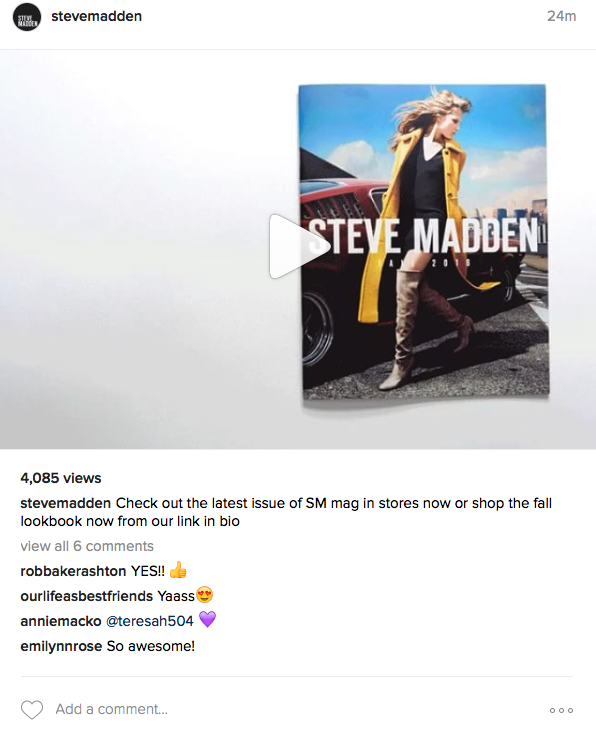Learning Hub | Digital Marketing Basics
Marketing Master: The Instagram Essentials
October 7, 2016 | Jon Teodoro

The old saying goes, “A picture is worth a thousand words.”
Nowadays, it would be accurate if it said, “A picture is worth a thousand likes.”
Social media is all about the likes (a.k.a. the shares, the hearts, the retweets). “Likes” have become the Internet equivalent of hugs and kisses. A like can show support, indicate agreement, say “I’m sorry,” and much, much more.
Instagram, a popular photo-sharing platform, may feature its like button as a heart, but the end idea is the same – likes are good. And with over 400 million active monthly users, it isn’t hard to imagine your picture being worth a thousand or so. Unless you’re Kylie Jenner, in which case it would be worth more like a few million (goals?!).
So, what does sharing photos have to do with advertising and business growth? Used correctly, social media is one of the most important marketing tools currently, and each platform offers up different opportunities.
Let’s take a look at how you can optimize your Instagram marketing to promote your company’s brand, build a bigger, better audience and grow your business.
Marketing on Instagram: The Basics
Are you an Instagram newbie?
Like with any piece of technology, there is a learning curve to “Insta.” Luckily, social media creators want to make their apps super user friendly so that as many people will use them as possible.
Instagram is great because all you need is a photo to get started. After you upload your picture, you can play around with filters and editing software for a professional look, write long posts (characters aren’t prohibited to a max like on Twitter), and build a successful hashtag to engage your audience members.
It isn’t too complicated, but let’s go over some marketing basics.
1. It’s all about the hashtag so choose them wisely.
Instagram’s hashtag (#) is pretty much the key to sharing your photos with people that don’t already follow you. It also connects your company with those that do and makes it easier for them to share your brand with others.
The hashtag is like an indicator followed by keywords that can add to your brand, advertise benefits of your products or offer catchy taglines that customers can’t forget.
Instagram works much like Facebook in the sense that your followers (those that have chosen to follow your page) will see your posts automatically on their feed (where they scroll through all photo updates).
If these were the only people that could see your photos, you would have to work a lot harder to build up your Insta audience. Luckily, if you set your profile to public (which for a business is a must), your posts can be seen by anyone on Instagram, and they don’t even have to know your account name.
Under the search and explore tab, any user can look up people (names), hashtags and places, and Instagram spits out matching results. This means that interested parties can look you up using your company name, but they can also search for a popular hashtag associated with your business.
A hashtag can be anything, but it is a good idea to sprinkle some that are popularly used along with some that you create as your company’s personal hashtags. They should always help build your brand, but the possibilities are endless. You can get truly creative.
Examples (click on any link to see Instagram tags at work):
- Locations: #Picturedrocks, #Michigan, #Detroit, #NY, #NewYork, #Cali, #EastCoast, #philly, #Hamptonlife.
- Notice that capitalization is more of a preference than a grammar fact. Tags show up no matter the cap. situation as long as they are spelled correctly. Also, there are no spaces between words or else the tag will be broken and unrecognized by Insta.
- Product Specific: #Shamwow, #cocacola, #starbuckschick, #GreenPaper, #MaxYourWax, #ssekostyle
- These product tags are names and descriptors. I made some of these up, but the others currently exist. #ssekostyle is one used by Sseko Designs, a footwear and accessories brand based in East Africa. I thought up #MaxYourWax as one that could be used by a car detail company to advertise its waxing services.
- Well-known Brand Tags: #pickyourpepper, #jonessoda, #justdoit, #REVOLVEme
- You may know what some of these are without having ever been on Instagram. If that’s the case, you can see how popular hashtags have become in our current culture. Type any of these into Insta search to see how branding is built through hashtags and how this type of free advertising is extremely successful.
2. Connect with your Facebook page.
Facebook and Instagram are linked so in order to create Insta ads through the Facebook Power Editor, you need to first connect your profiles. The two must be linked before you can start advertising on Instagram.
You can also pull contacts from your Facebook followers, which is a nice bonus.
3. Use existing contacts to build your followers.
You can sync your Instagram account with your contacts on your phone or tablet. Insta can search for accounts with matching emails and/or phone numbers to your contacts list. Then, it will provide you with follow suggestions so that you can easily connect with those that are active users.
By following people that already connect with you or your business, you are starting out with a good target audience.
From Insta’s help center, “When you connect Instagram with your phone or tablet’s contact list, you’ll be able to see a list of your contacts who are on Instagram. You can choose contacts to follow from this list. When your contact list is connected, it’s periodically synced and securely stored on our servers. You can disconnect your contacts at any time.”
4. Build off of existing customers’ or connections’ large Instagram followings.
People in the marketing world are starting to throw around the idea of “influencer marketing.” According to tapinfluence, “Influencer marketing is a type of marketing that focuses on using key leaders to drive your brand’s message to the larger market. Rather than marketing directly to a large group of consumers, you instead inspire/hire/pay influencers to get out the word for you.”
Do you do business with anyone that has a large following? Do any celebrities use your product? Would they post about it? Does a well-known blogger like your book?
The ways in which you can be connected to an influencer are numerous. Maybe a local celeb or newsperson loves your restaurant and wrote a blog review about it. You could reach out to see if he/she would share it on Instagram.
There are such things on Insta as sponsored ads (like those that you see at the top of a Google SERP), and they are labeled. This is like paying for a newspaper or magazine ad. Instagram can utilize its knowledge database to match your ad with people that it thinks will be most interested (match your demographic).
Although this is an ethical option, money doesn’t have to be involved in attracting influencers.
A better practice would be to see if there are any influencers that are already familiar with your company or product. If so, reach out to them to see if they would be interested in promoting your services or giving you a shout-out on their page.
Finding influencers is a like getting backlinks to your website. You don’t have to pay for them, but can instead focus on networking and building long-lasting relationships so that people will want to advertise you – for free!
It can take time, but an endorsement from someone with a large Insta audience can boost your following quicker than you can say influencer marketing.
5. Link your Instagram and email marketing for more successful and engaged campaigns.
Do you have an email marketing campaign going? If so, messages are a great place to make customers aware of your hashtags and your Instagram presence. By cleverly placing tags in the subject or body, you can build a branding message around a sale or offer. Make sure to put a CTA in there so that your readers can go straight to your Instagram and connect with you.
6. Choose which ads are right for you.
There are different ad types (not including sponsored) that you can use on Instagram. Let’s take a look at the top three options:
1. Image
- Images are the bread and butter of Instagram. Image ads need to be professional, high-def, well-organized and attention-grabbing. Add a punchy, descriptive tagline that will persuade users to shop and a CTA that directs them straight to the products page for a quick check-out.

2. Video
- Videos can be a fantastic visual resource. Instagram videos are short (60 seconds), but they can provide supplemental material that adds to your company’s identity. They’re also more inviting, making users feel connected to your brand.
- Videos are engaging and attention-grabbing. Here’s an example from @stevemadden.

3. Carousel
- The carousel is a relatively new Insta ad format. It looks similar to a regular photo post, but with one main difference. There are three circles below the photo that indicate you can swipe to the right. Once you do, you will see more pictures.
- From Instagram for Business, “One way to look at it is carousel ads bring the potential of multi-page print campaigns to mobile phones – with the added benefit of taking people to a website to learn more.”
- These are being used to advertise clothing lines, phone models and stills from popular television shows. Plus, you get to add a link to any site page of your choosing.
- For a successful carousel, use high-def photos that grab attention, supplement them with great copy, tell a story that keeps users wanting more and add a compelling CTA so they will click-through.
- One successful carousel ad comes from @pencilsofpromise, a for-purpose org. that is dedicated to seeing that all children receive an education. After swiping through the photos (the post copy, offering a brief description, stays the same throughout), a CTA (in this case, “Learn More”) directs you to the Pencils of Promise site where you can donate.
- For other carousel ad examples, check out the first brands to use Instagram’s carousel ads.
7. Throw a smaller net.
By targeting ads, you can be sure to put them in front of the people who are most likely to engage with your company. Instagram target options resemble those on Facebook.
You can narrow down your ad’s deliverable audience by demographics, interests, online activity and more. To make the most out of your targeted ads, be familiar with your buyer personas.
8. Call your followers to action.
CTA’s are important for pretty much every form of marketing, and Instagram is no different. We touched on them above, but as always, make sure that CTA’s are short and compelling.
One different aspect of Insta is that you cannot put live links in your post copy. That is why many users write “link in bio”on a post. This tells viewers to go to their main profile page and click the link in their short bio (at the top of everyone’s individual page) if they are interested.
Copy plays a crucial role in all of this. Since there is an added step in the process, you need to focus on wording that will entice followers, guiding them further down the buyer’s funnel in order to make a sale.
Another important thing to note is that you can ensure your link fits nice and cozy into the window by using a shortening service like Bit.ly.
9. Connect with your followers.
Seeing isn’t always believing. Your followers may see your posts and love them. But, social media enthusiasts crave connection.
Twitter has the retweet, and Facebook the share. One way to actively connect with your Insta followers is to repost.
Reposting is also a beneficial way to advertise for free. Say someone uses your hashtag (#bibyourbaby) in a photo of a baby wearing one of your personalized bibs. You can repost it, drawing audience awareness to your personal customer interaction and the cute product you designed. You’ll also make the posting parent proud, and he or she may be more likely to shop in the future.
Win, win, WIN.
It’s not hard to repost, but unfortunately it’s not as simple as pushing one button like with other apps.
How to repost:
- Download the free Repost for Instagram app (iOS and Android).
- Login using your Instagram credentials.
- View your feed in the Repost app, and select which photo you’d like to share.
- A bar will pop up, and you can hit repost to share on your Instagram feed.
People like to be “reposted” probably about as much as Shakespeare would like to see how many times he’s been quoted.
You’re so vain….
I bet you think this post is about you, don’t you…
Just kidding, but reposting will make your followers feel connected to you and your brand. You can also comment back to specific people by using the @ followed by their username for a direct form of interaction.
10. Review your Instagram success for optimization.
As with any form of marketing, it isn’t all about guesswork. Tracking your Instagram success allows you to see what is working and what isn’t.
Use this formula to get started:
Engagement rate = (likes + comments) / followers at time of post
There are several online tools to help you track how many people have used your hashtag or tagged you in a post, and you can create different URL landing pages for different types of ads so that you can measure and compare click-through rates.
Take what works and what doesn’t into account so that you can optimize your Insta campaign to generate the most leads and convert the most customers with as little work as possible.
How Instagram Marketing can Help Business
As you have seen from the examples above, Instagram is an awesome platform where you can allow your followers to virtually window shop.
Instagram is informative, but in a visual rather than text-driven way. It is attention-grabbing, but unobtrusive. People have to choose to search or follow you so engagement is high.
It is a creative platform. Whole profiles should play up to the brand’s image so much so that when a photo comes across a feed, users know who posted it without seeing a name.
As powerful as the golden arches are to Mickey D’s, a successful Instagram profile is to lead generation and increased conversion rates.
When done well, Instagram can help you pin down a target audience, advertise your services, solidify your brand and bring your business into the networking age to build your reputation and increase your profits.
Check out the examples below for some inspirational mojo.
Excellent Instagram Marketing Examples: Sister Pie and Jessica Walsh
@sisterpiedetroit – We have mentioned local bakery Sister Pie before as a marketing example, but Instagram is what put these pie ladies on the map. With over 24 thousand followers, Sister Pie’s Instagram is constantly updating users on daily pie specials, seasonal buys at the farmers market, goings-on around the shop and (my favorite) the occasional dance break video.
Super personal and fun, this pie profile is a great example of using Insta for customer engagement, lunch specials announcements and business updates. Goofy, down-to-earth videos introduce the staff and make you feel connected. Pictures of farm-fresh ingredients and flaky crusts make your mouth water. Both make you want to buy.
@jessicavwalsh – This is a good example of how an Instagram profile can simply be used as an art form to build a brand.
Jessica Walsh is an art director and designer in NYC. Instead of using her profile to sell, she uses it as an attached arm to her art style and to build her brand. She does have a URL in her bio to her website, but that’s it.
Posts are color-blocked, vibrant, creative and fun. Filled with weird images and textures, spunky quotes, outrageously cute outfits, videos and the occasional dreamy travel scene, her profile gets an A+ for branding.
If one of her posts comes across your feed, you know it’s from her immediately – that is how established her image is. It’s extremely successful, but you can see that she puts time and effort into it.
In Conclusion
The above examples are all great. There is no one way to have a successful Instagram profile. Get creative. Pull from inspirations, but make it your own.
You first need to have a brand identity in mind. From there, the Insta world is your oyster.
Have you seen any awesome examples of Instagram marketing? Please share them with us below.
